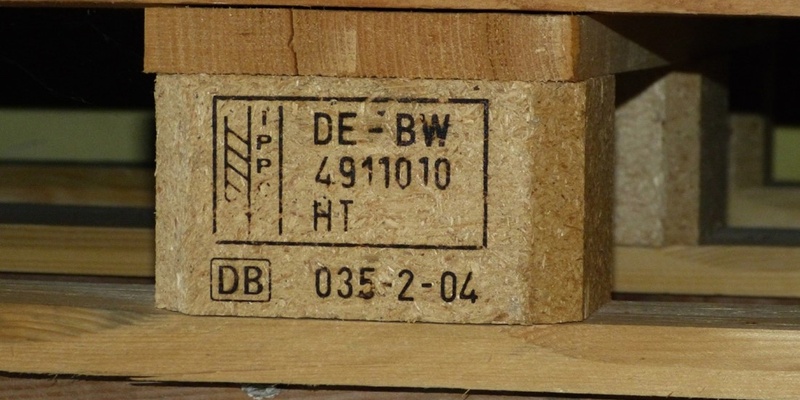SPOTLIGHT: Prevent. Protect. Sustain. How the IPPC is protecting agriculture and trade by reducing the risk of pest spread through wood packaging material
Posted on Thu, 14 Sep 2023, 13:42

©BMEL/T. Schroeder
The volume of international trade today is roughly 45 times the level recorded in 1950 and is projected to grow by 1.7 percent in 2023 before picking up to 3.2 percent in 2024. As global trade grows in volume, geographic scope, speed, diversity, and types or number of conveyances, the pathways for plant pests to cross international borders through trade also increase. One of these pathways is wood packaging material (WPM) made from raw wood. About 80 percent of all consignments moving in international trade include some form of WPM. This is a major concern for the International Plant Protection Convention (IPPC).
Wood packaging material refers to wood or wood products (excluding paper products) used to support, protect or carry a commodity, such as pallets, drums, spools, reels, crates, and dunnage. WPM is made from wood of dead or living trees and may harbor pests such as insects like bark beetles, fungi, nematodes and other organisms that rely on trees for food and shelter. If these pests are introduced to a new area, they may affect tree health, forest ecosystems, and forest productivity.
Since WPM is used by almost all industries and may be associated with consignments of goods that would not ordinarily be subjected to phytosanitary regulation, it is important to use treated or processed wood – to kill or remove the pests - to manufacture WPM used in global trade. Short of this, pests may be carried around the world, where they can disrupt agriculture and trade. This is why the IPPC developed, adopted and promotes the International Standard for Phytosanitary Measures (ISPM) 15 (Regulation of wood packaging material in international trade).
ISPM 15: Preventing pest risk from WPM
This standard, adopted in 2002, outlines phytosanitary measures for WPM. It encourages IPPC contracting parties to harmonize their approaches in reducing the risk of introduction and spread of pests associated with WPM moving in international trade.
WPM units can circulate in world trade for several years and may be used many times before being discarded. This increases chances of introducing pests to new regions and it also makes it difficult to identify the point of origin of individual WPM units. The IPPC thus recognizes that it is not feasible to apply country-specific phytosanitary import requirements for WPM in global trade.

©BMEL/T. Schroeder
Furthermore, ISPM 15 facilitates trade by replacing the need for phytosanitary certificates with an easily recognized mark on the WPM. The mark confirms that the WPM was subjected to a phytosanitary treatment following the standard. It makes it easy to trace the WPM back to the country where the treatment occurred and to the entity that authorized it. The ISPM 15 mark is easily identifiable, and this simplifies verification and inspection of individual units of WPM.
Through its Implementation and Facilitation Unit (IFU), the IPPC Secretariat is working to increase the level of awareness and knowledge among stakeholders and some national plant protection organizations (NPPOs) about the standard, its application and how it can ease trade. The secretariat also intends to help address challenges related to applying the ISPM 15-mark, authorizing WPM treatment providers and producers, and inspecting imported WPM.
IPPC produces technical Guide to assist countries implement ISPM 15
 |
Published in April this year, the IPPC Guide to the regulation of wood packaging material: Understanding the phytosanitary requirements for the movement of wood packaging material in international trade helps countries implement ISPM 15, and in so doing, reduce the risk of introducing and spreading forest pests. The Guide includes photos, flowcharts, checklists and forms that offer NPPOs practical guidance to address key challenges and fulfil their roles and responsibilities to apply international phytosanitary measures enshrined in ISPM 15.
The WPM Guide also describes procedures for producing wood packaging material compliant with ISPM 15. NPPO staff, ISPM 15 treatment providers, wood packaging material manufacturers, repairers, remanufacturers, and other stakeholders can use this Guide to simplify their work and improve exchange of technical and official phytosanitary information related to ISPM 15. With better collaboration comes better implementation and so through the Guide, the IPPC Secretariat encourages NPPOs to collaborate with other national agencies like their national customs and port authorities to enhance border controls and improve detection of non-compliant WPM.
“This IPPC resource is a valuable addition to the library of IPPC guides and training materials. It provides practical information and suggests best practices to support national plant protection organizations in effectively implementing ISPM 15. By doing so, it helps to mitigate the risk of spreading forest pests and eases trade in goods transported using wood packaging material,” said Osama El-Lissy, IPPC Secretary.
Success story: Denmark uses public education campaigns to reduce pest risk from wood packaging material
In 2021, the Danish Agricultural Agency (NPPO of Denmark) carried out two awareness raising campaigns, targeting the private sector and the public. The campaigns focused on educating stakeholders about the risk of introduction and spread of quarantine pests associated with WPM. The intention was to draw attention to the symptoms of a pest infestation and to inform stakeholders of their obligation to report suspected pests.
Various media channels and tools were used: a press release distributed to print and broadcast media outlets, special interest groups and specialised publications, social media, topical articles, a short video, and website content on the importance of using treated and ISPM 15 marked WPM in international trade. Engaging the media was very important to create awareness and engage inspectors to ensure that they have the same information and knowledge as WPM manufacturers and treatment providers.
Denmark identified and engaged companies involved in repairing and remanufacturing WPM without the NPPO’s authorization, with the goal of sensitizing them about ISPM 15 and the associated European Union (EU) plant health regulation. The NPPO encouraged companies to register if they carry out ISPM 15 activities that require authorization of the NPPO. The campaign was a success; the Danish NPPO engaged several companies and saw an increase in registrations of new ISPM 15 companies.
“As NPPO, we of course communicate about plant health to relatively specific target groups. When it comes to ISPM15 and wood packaging, it is particularly relevant to reach out to the general population, transporters, warehouse workers and not only people involved with plants. All types of goods use wood packaging, and therefore there is no precise and defined target group as such. This makes the communication task more difficult, but also more fun”, said Kristine Riskær, Head of Department Plant & Biosecurity, the Danish Agricultural Agency.
 |
| Illustration used during BREXIT to inform companies that the United Kingdom and the EU require imported wooden packaging material to have the ISPM 15 mark. Translation of illustration text: ”Are you sending or receiving wooden packaging material from the UK? A marked pallet is an approved pallet” |
To find out more about IPPC guides and e-learnings REGISTER for the IPPC-led webinar on 19 October 2023 where all new IPPC guides and e-learnings published in 2022 and 2023 will be presented, including the IPPC Guide to the regulation of wood packaging material.
Related information
News: IPPC publishes new guide on wood packaging material
Link to the IPPC Guide to the regulation of wood packaging material

